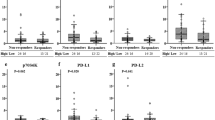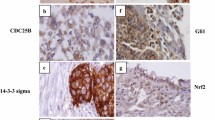Abstract
Purpose
The purpose of this study was to evaluate the use of thymidilate synthetase (TS), thymidilate phosphorylase (TP), dihydropyrimidin dehydrogenase (DPD), Her-2/neu, and cyclin D1 as predictors of therapy response, survival, and recurrence in patients with esophageal squamous cell carcinoma (ESCC) following radiochemotherapy.
Materials and methods
Twenty-six patients with histologically proven intrathoracic, locally advanced ESCC (cT3, cN0/+, cM0) underwent preoperative, combined simultaneous radiochemotherapy followed by R0-transthoracic esophagectomy. Because R0 resection is the strongest known independent prognostic factor in this tumor entity, only R0-resected patients were included in this study. Pre-therapeutically taken, formalin-fixed, and paraffin-embedded tumor biopsies were used for laser-assisted microdissection of tumor cells and RNA extraction and subjected to real-time (TaqMan) quantitative reverse transcriptase-polymerase chain reaction (Q-RT-PCR).
Results
No significant correlation between clinical or histopathological parameters and the relative gene expression of TS, TP, DPD, or Her-2/neu was observed. However, patients with relative cyclin D1 levels below the median gene expression did not reach median survival compared to the 19.9 months seen in patients with relative cyclin D1 gene expression above the median (P = 0.02). Patients with low cyclin D1 levels experienced significantly less frequent recurrence of the tumor (20% versus 63%; P = 0.006), and there was a significant difference in the recurrence-free interval (P = 0.003).
Conclusions
Despite the small number of investigated patients, our data seem to show that high levels of cyclin D1 measured by real-time Q-RT-PCR before neoadjuvant radiochemotherapy correlate significantly with patient survival, tumor recurrence, and recurrence-free-interval. Cyclin D1 might be useful in identifying patients at high risk of poor prognosis and suffering from recurrence after neoadjuvant radiochemotherapy treatment and R0 resection. Further investigations with a larger cohort are warranted.

Similar content being viewed by others
Abbreviations
- AUC:
-
area-under-curve
- CTx:
-
chemotherapy
- CI:
-
confidence interval
- DPD:
-
dihydropyrimidin dehydrogenase
- DEPC:
-
di-ethyl-pyro-carbonate
- ESCC:
-
esophageal squamous cell carcinoma
- RTx:
-
radiotherapy
- RTx/CTx:
-
radiochemotherapy
- TS:
-
Thymidilate synthetase
- TP:
-
Thymidilate phosphorylase
- 5-FU:
-
5-fluorouracil
References
Lehnert T (1999) Multimodal therapy for squamous carcinoma of the oesophagus. Br J Surg 86:727–739
Ancona E, Ruol A, Santi S, Merigliano S, Sileni VC, Koussis H, Zaninotto G, Bonavina L, Peracchia A (2001) Only pathologic complete response to neoadjuvant chemotherapy improves significantly the long term survival of patients with resectable esophageal squamous cell carcinoma: final report of a randomized, controlled trial of preoperative chemotherapy versus surgery alone. Cancer 91:2165–2174
Law S, Fok M, Chow S, Chu KM, Wong J (1997) Preoperative chemotherapy versus surgical therapy alone for squamous cell carcinoma of the esophagus: a prospective randomized trial [see comments]. J Thorac Cardiovasc Surg 114:210–217
Brücher BLDM, Stein HJ, Zimmermann F, Werner M, Sarbia M, Busch R, Dittler HJ, Molls M, Fink U, Siewert JR (2004) Responders benefit from neoadjuvant radiochemotherapy in esophageal squamous cell carcinoma: results of a prospective phase-II-trial. EJSO 30(9):963–971
Brücher BLDM, Weber W, Bauer M, Fink U, Avril N, Stein HJ, Werner M, Zimmermann F, Schwaiger M, Siewert JR (2001) Neoadjuvant therapy in esophageal squamous cell carcinoma: Response evaluation by positron emission tomography. Ann Surg 233(3):300–309
Flamen P, Van Cutsem E, Lerut A, Cambier JP, Haustermans K, Bormans G, De Leyn P, Van Raemdonck D, De Wever W, Ectors N, Maes A, Mortelmans L (2002) Positron emission tomography for assessment of the response to induction radiochemotherapy in locally advanced oesophageal cancer. Ann Oncol 13:361–368
Wieder HA, Brücher BLDM, Zimmermann F, Becker K, Lordick F, Beer A, Schwaiger M, Fink U, Siewert JR, Stein HJ, Weber WA (2004) Time course of tumor metabolic activity during chemoradiotherapy of esophageal squamous cell carcinoma and response to treatment. J Clin Oncol 22:900–908
Brücher BLDM, Becker K, Lordick F, Fink U, Sarbia M, Stein H, Busch R, Zimmermann F, Molls M, Hofler H, Siewert JR (2006) The clinical impact of histopathologic response assessment by residual tumor cell quantification in esophageal squamous cell carcinomas. Cancer 106:2119–2127
Langer R, Specht K, Becker K, Ewald P, Bekesch M, Sarbia M, Busch R, Feith M, Stein HJ, Siewert JR, Hofler H (2005) Association of pretherapeutic expression of chemotherapy-related genes with response to neoadjuvant chemotherapy in Barrett carcinoma. Clin Cancer Res 11:7462–7469
Napieralski R, Ott K, Kremer M, Specht K, Vogelsang H, Becker K, Muller M, Lordick F, Fink U, Rudiger Siewert J, Hofler H, Keller G (2005) Combined GADD45A and thymidine phosphorylase expression levels predict response and survival of neoadjuvant-treated gastric cancer patients. Clin Cancer Res 11:3025–3031
Specht K, Richter T, Muller U, Walch A, Hofler MW (2000) Quantitative gene expression analysis in microdissected archival tissue by real-time RT-PCR. J Mol Med 78:B27
Specht K, Richter T, Muller U, Walch A, Werner M, Hofler H (2001) Quantitative gene expression analysis in microdissected archival formalin-fixed and paraffin-embedded tumor tissue. Am J Pathol 158:419–429
Brücher BLDM, Stein HJ, Werner M, Siewert JR (2001) Lymphangiosis carcinomatosa is an independent prognostic factor in primary resected patients with esophageal squamous cell carcinoma. Cancer 92(8):2228–2233
Bartels H, Stein HJ, Siewert JR (1998) Preoperative risk analysis and postoperative mortality of oesophagectomy for resectable oesophageal cancer. Br J Surg 85:840–844
Miller AB, Hoogstraten B, Staquet M, Winkler A (1981) Reporting results of cancer treatment. Cancer 47:207–214
Siewert JR, Hölscher AH, Roder JD, Bartels H (1998) En-bloc esophagectomy in esophageal cancer. Langenbecks Arch Chir 373:367–376
Wittekind C, Compton CC, Greene FL, Sobin LH (2002) TNM residual tumor classification revisited. Cancer 94:2511–2516
Sobin LH, Wittekind C (2002) TNM classification of malignant tumors, 6th edn. Springer, New York
Becker I, Becker KF, Rohrl MH, Minkus G, Schutze K, Hofler H (1996) Single-cell mutation analysis of tumors from stained histologic slides. Lab Invest 75:801–807
Gibson UE, Heid CA, Williams PM (1996) A novel method for real time quantitative RT-PCR. Genome Res 6:995–1001
Heid CA, Stevens J, Livak KJ, Williams PM (1996) Real time quantitative PCR. Genome Res 6:986–994
Kaplan EL, Meier P (1958) Nonparametric estimation from incomplete observations. A Am Stat Assoc 75:457–487
Peto R, Pike MC, Armitage P, Breslow NE, Cox DR, Howard SV, Mantel N, McPherson K, Peto J, Smith PG (1977) Design and analysis of randomized clinical trials requiring prolonged observation of each patient. II. Analysis and examples. Br J Cancer 35:1–39
Dittler HJ (2002) Surgical endoscopy for staging and the selection of procedure. Chirurg 73:2–8
Dittler HJ, Fink U, Siewert GR (1994) Response to chemotherapy in esophageal cancer. Endoscopy 26:769–771
Hordijk ML, Kok TC, Wilson JH, Mulder AH (1993) Assessment of response of esophageal carcinoma to induction chemotherapy. Endoscopy 25:592–596
Isenberg G, Chak A, Canto MI, Levitan N, Clayman J, Pollack BJ, Sivak MV Jr. (1998) Endoscopic ultrasound in restaging of esophageal cancer after neoadjuvant chemoradiation. Gastrointest Endosc 48:158–163
Laterza E, de Manzoni G, Guglielmi A, Rodella L, Tedesco P, Cordiano C (1999) Endoscopic ultrasonography in the staging of esophageal carcinoma after preoperative radiotherapy and chemotherapy. Ann Thorac Surg 67:1466–1469
Mallery S, Van Dam J (1999) Interventional endoscopic ultrasonography: current status and future direction. J Clin Gastroenterol 29:297–305
Roubein LD, DuBrow R, David C, Lynch P, Fornage B, Ajani J, Roth J, Levin B (1993) Endoscopic ultrasonography in the quantitative assessment of response to chemotherapy in patients with adenocarcinoma of the esophagus and esophagogastric junction. Endoscopy 25:587–591
Arnott SJ, Duncan W, Gignoux M, Girling DJ, Hansen HS, Launois B, Nygaard K, Parmar MK, Roussel A, Spiliopoulos G, Stewart LA, Tierney JF, Mei W, Rugang Z (1998) Preoperative radiotherapy in esophageal carcinoma: a meta-analysis using individual patient data (Oesophageal Cancer Collaborative Group). Int J Radiat Oncol Biol Phys 41:579–583
Nygaard K, Hagen S, Hansen HS, Hatlevoll R, Hultborn R, Jakobsen A, Mantyla M, Modig H, Munck-Wikland E, Rosengren B et al (1992) Pre-operative radiotherapy prolongs survival in operable esophageal carcinoma: a randomized, multicenter study of pre-operative radiotherapy and chemotherapy. The Second Scandinavian Trial in Esophageal Cancer. World J Surg 16:1104–1109, discussion 1110
Roth JA, Pass HI, Flanagan MM, Graeber GM, Rosenberg JC, Steinberg S (1988) Randomized clinical trial of preoperative and postoperative adjuvant chemotherapy with cisplatin, vindesine, and bleomycin for carcinoma of the esophagus. J Thorac Cardiovasc Surg 96:242–248
Kelsen DP, Ginsberg R, Pajak TF, Sheahan DG, Gunderson L, Mortimer J, Estes N, Haller DG, Ajani J, Kocha W, Minsky BD, Roth JA (1998) Chemotherapy followed by surgery compared with surgery alone for localized esophageal cancer. N Engl J Med 339:1979–1984
Group. MRCMUGTC (2000) Medical Research Council (MRC) randomised phase III trial of surgery with or without pre-operative chemotherapy in resectable cancer of the esophagus. Br J Surgery 83:1, (abstract)
Siewert JR, Stein HJ, Feith M, Brücher BLDM, Bartels H, Fink U (2001) Histologic tumor type is an independent prognostic parameter in esophageal cancer: lessons from more than 1,000 consecutive resections at a single center in the western world. Ann Surg 234:360–369
Izzo JG, Papadimitrakopoulou VA, Liu DD, den Hollander PL, Babenko IM, Keck J, El-Naggar AK, Shin DM, Lee JJ, Hong WK, Hittelman WN (2003) Cyclin D1 genotype, response to biochemoprevention, and progression rate to upper aerodigestive tract cancer. J Natl Cancer Inst 95:198–205
Izzo JG, Papadimitrakopoulou VA, Li XQ, Ibarguen H, Lee JS, Ro JY, El-Naggar A, Hong WK, Hittelman WN (1998) Dysregulated cyclin D1 expression early in head and neck tumorigenesis: in vivo evidence for an association with subsequent gene amplification. Oncogene 17:2313–2322
Papadimitrakopoulou VA, Izzo J, Mao L, Keck J, Hamilton D, Shin DM, El-Naggar A, den Hollander P, Liu D, Hittelman WN, Hong WK (2001) Cyclin D1 and p16 alterations in advanced premalignant lesions of the upper aerodigestive tract: role in response to chemoprevention and cancer development. Clin Cancer Res 7:3127–3134
Sarbia M, Gabbert HE (2000) Modern pathology: prognostic parameters in squamous cell carcinoma of the esophagus: recent results. Cancer Res 155:15–27
Sarbia M, Stahl M, Fink U, Heep H, Dutkowski P, Willers R, Seeber S, Gabbert HE (1999) Prognostic significance of cyclin D1 in esophageal squamous cell carcinoma patients treated with surgery alone or combined therapy modalities. Int J Cancer 84:86–91
Harpole DH Jr., Moore MB, Herndon JE 2nd, Aloia T, D’Amico TA, Sporn T, Parr A, Linoila I, Allegra C (2001) The prognostic value of molecular marker analysis in patients treated with trimodality therapy for esophageal cancer. Clin Cancer Res 7:562–569
Johnston PG, Lenz HJ, Leichman CG, Danenberg KD, Allegra CJ, Danenberg PV, Leichman L (1995) Thymidylate synthase gene and protein expression correlate and are associated with response to 5-fluorouracil in human colorectal and gastric tumors. Cancer Res 55:1407–1412
Kirihara Y, Yamamoto W, Toge T, Nishiyama M (1999) Dihydropyrimidine dehydrogenase, multidrug resistance-associated protein, and thymidylate synthase gene expression levels can predict 5-fluorouracil resistance in human gastrointestinal cancer cells. Int J Oncol 14:551–556
Levine EL, Renehan A, Gossiel R, Davidson SE, Roberts SA, Chadwick C, Wilks DP, Potten CS, Hendry JH, Hunter RD et al (1995) Apoptosis, intrinsic radiosensitivity and prediction of radiotherapy response in cervical carcinoma. Radiother Oncol 37:1–9
Nakano T, Oka K, Ishikawa A, Morita S (1998) Immunohistochemical prediction of radiation response and local control in radiation therapy for cervical cancer. Cancer Detect Prev 22:120–128
Samejima R, Kitajima Y, Yunotani S, Miyazaki K (1999) Cyclin D1 is a possible predictor of sensitivity to chemoradiotherapy for esophageal squamous cell carcinoma. Anticancer Res 19(16C):5515–5521
Toyoda H, Nakamura T, Shinoda M, Suzuku T, Hatooka S, Kobayashi S, Ohashi K, Seto M, Shiku H, Nakamura S (2000) Cyclin D1 expression is useful as a prognostic indicator for advanced esophageal carcinomas, but not for superficial tumors. Dig Dis Sci 45(5):864–869
Acknowledgment
The authors wish to dedicate this manuscript to their distinguished colleague and friend Dr. med. Hans-Joachim Dittler, Department of Surgery, Technical University of Munich, who died in 2007.
Author information
Authors and Affiliations
Corresponding author
Additional information
This manuscript contains original material which is not under consideration by another journal.
Rights and permissions
About this article
Cite this article
Brücher, B.L.D.M., Keller, G., Werner, M. et al. Using Q-RT-PCR to measure cyclin D1, TS, TP, DPD, and Her-2/neu as predictors for response, survival, and recurrence in patients with esophageal squamous cell carcinoma following radiochemotherapy. Int J Colorectal Dis 24, 69–77 (2009). https://doi.org/10.1007/s00384-008-0562-5
Accepted:
Published:
Issue Date:
DOI: https://doi.org/10.1007/s00384-008-0562-5




